Meat Packaging Market Size and Share
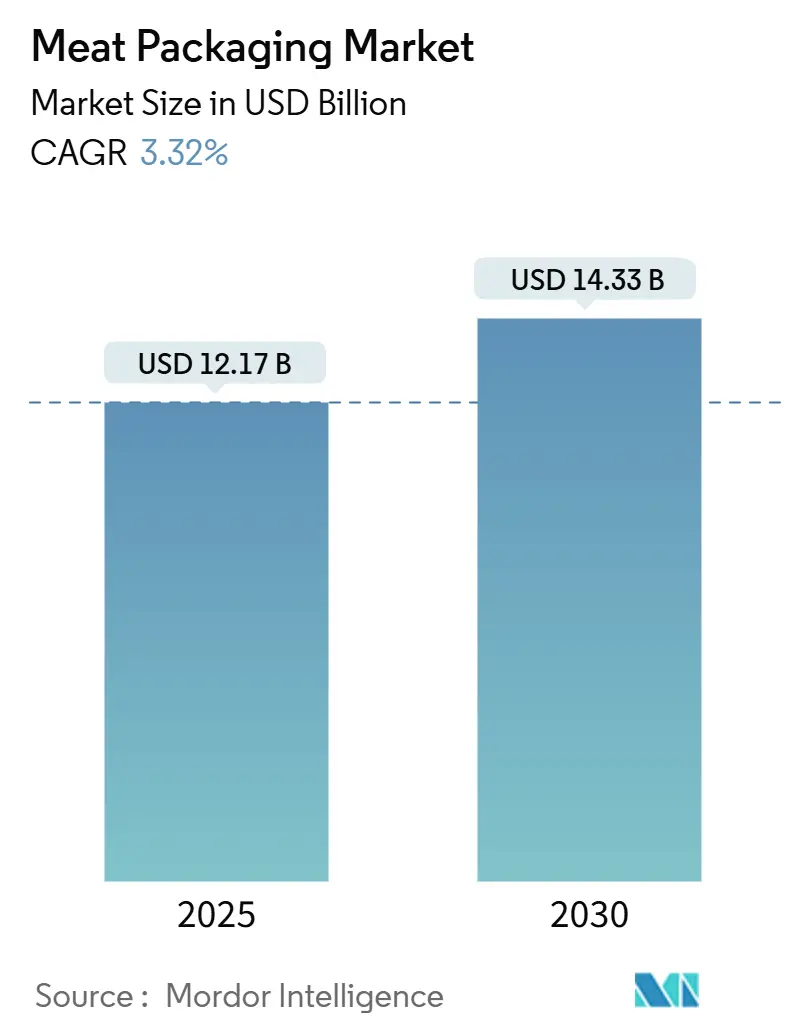
Meat Packaging Market Analysis by Mordor Intelligence
The meat packaging market size reached USD 12.17 billion in 2025 and is forecast to grow to USD 14.33 billion by 2030 at a 3.32% CAGR. Growth reflects steady demand for convenience meat formats, widening adoption of cold-chain logistics, and tightening global food-safety and sustainability rules. Flexible plastics, modified-atmosphere formats, and high-barrier mono-materials dominate specifications as retailers push longer shelf life and stronger visual appeal. Asia-Pacific drives the largest volumes, while online grocery and meal-kit channels record the fastest incremental gains. Plastic-waste regulation, raw-material volatility, and the rise of alternative proteins temper margin outlooks, encouraging producers to pursue recyclable films, automation, and smart-packaging innovations.
Key Report Takeaways
- By material type, flexible plastic captured 42% of meat packaging market share in 2024, while biodegradable films post the fastest 7.2% CAGR through 2030.
- By meat type, fresh and frozen meat accounted for 54% of the meat packaging market size in 2024; ready-to-eat meat is advancing at a 5.5% CAGR to 2030.
- By packaging technology, Modified Atmosphere Packaging led with 48% share in 2024; active and intelligent formats are projected to expand at a 7.8% CAGR through 2030.
- By end-user channel, retail held 51% of the meat packaging market size in 2024, whereas online grocery and meal-kit delivery are registering an 8.1% CAGR to 2030.
- By geography, Asia-Pacific generated 34% of the meat packaging market size in 2024 and is growing at a 4.8% CAGR to 2030.
- Amcor, Sealed Air, and Berry Global collectively account for a dominant revenue position, sustained by scale and R&D depth.
Global Meat Packaging Market Trends and Insights
Drivers Impact Analysis
| DRIVER | (~) % IMPACT ON CAGR FORECAST | GEOGRAPHIC RELEVANCE | IMPACT TIMELINE |
|---|---|---|---|
| Demand for convenience and RTE meat products | +0.8% | Global, with stronger impact in North America & APAC | Medium term (2-4 years) |
| Expansion of organized retail and cold-chain logistics | +0.6% | APAC core, spill-over to MEA and South America | Long term (≥ 4 years) |
| Shelf-life extension and food safety regulations | +0.5% | Global, led by EU and North America | Short term (≤ 2 years) |
| Sustainability-led shift to high-barrier mono-materials | +0.4% | Europe & North America, expanding to APAC | Medium term (2-4 years) |
| Adoption of antimicrobial/nanocomposite films | +0.3% | North America & EU, pilot programs in APAC | Long term (≥ 4 years) |
| Blockchain-enabled traceability and tamper-evident formats | +0.2% | North America & EU premium segments | Long term (≥ 4 years) |
| Source: Mordor Intelligence | |||
Demand for Convenience and Ready-to-Eat Meat Products
Consumer adoption of value-added meat rose from 37% to 67% between 2016 and 2022, pushing processors toward case-ready formats that minimise in-store handling while preserving colour and texture. Tyson Fresh Meats launched its Universal Case Ready Program to streamline distribution and extend shelf life via advanced barrier films. Urban shoppers, pressed for time, accept premium price points for packs enabling rapid meal preparation. Growth in fresh-prepared foods accelerates demand for high-pressure processing and modified-atmosphere systems that safeguard taste and nutrients. These dynamics reinforce sustained volume gains for the meat packaging market in both mature and emerging cities.[1]Richard Mitchell, “Value-added meats. Now packed with even more value,” Supermarket News, supermarketnews.com
Expansion of Organized Retail and Cold-Chain Logistics
Convenience-store sales in China climbed to CNY 424.8 billion in 2023, up 10.8% year on year, with fresh foods steering the rise. Start-ups such as Yueshi Robot are deploying autonomous forklifts operating at −30 °C, lifting efficiency in frozen distribution nodes. Broader commercial-refrigeration investment, projected to reach USD 56.2 billion by 2035, requires packaging that resists low-temperature stress while keeping oxygen ingress minimal. Retailers also demand standardised shapes to speed shelf replenishment, steering converters toward flexible pouches and thermoformed trays adapted for high-volume lines. These trends cement organised retail as a long-run catalyst for the meat packaging market.[2] Wataru Suzuki, “Chinese startups race to upgrade cold chain logistics,” Nikkei, asia.nikkei.com
Shelf-Life Extension and Food-Safety Regulations
Regulators tighten demands for verifiable freshness data, spurring interest in intelligent packs bearing colour-changing sensors and pH indicators. Academic research confirms gelatin-based pH sensors can integrate into biodegradable films, supplying real-time quality cues and reducing waste. The European Union’s Packaging and Packaging Waste Regulation elevates recyclability and traceability thresholds, prompting a shift to smart labels linked with cloud monitoring. Producers investing early in such systems gain compliance advantages and consumer trust, reinforcing adoption curves across the meat packaging market.
Sustainability-Led Shift to High-Barrier Mono-Materials
WestRock reported 96% of its 2023 portfolio as recyclable, compostable, or reusable, targeting 100% by 2025. LK Packaging’s PreservaWrap, a recyclable polyethylene film, now mirrors PVC barrier performance while qualifying for How2Recycle labelling. European directives accelerate the move away from complex laminates toward single-polymer structures, challenging material scientists to blend gas-barrier layers without compromising circularity. Progress in this area positions flexible producers to capitalise on eco-label demand in the meat packaging market.
Restraints Impact Analysis
| RESTRAINTS | (~) % IMPACT ON CAGR FORECAST | GEOGRAPHIC RELEVANCE | IMPACT TIMELINE |
|---|---|---|---|
| Plastic-waste regulations and recyclability challenges | -0.7% | Europe & North America, expanding globally | Short term (≤ 2 years) |
| Volatile polymer and metal input prices | -0.5% | Global, particularly impacting smaller processors | Short term (≤ 2 years) |
| Single-use-packaging taxes and EPR fees | -0.3% | Europe, pilot programs in North America | Medium term (2-4 years) |
| Growth of alternative proteins reducing red-meat demand | -0.2% | North America & Europe, emerging in APAC | Long term (≥ 4 years) |
| Source: Mordor Intelligence | |||
Adoption of Antimicrobial/Nanocomposite Films
Antimicrobial nanocomposites inhibit microbial growth directly on the meat surface, extending shelf life and lowering reliance on preservatives. Hydrogel carriers infused with natural extracts show efficacy in lowering bacterial counts while remaining food-safe. Pilot lines in North America and Europe are scaling production for commercial launch. Synergies arise when such films are paired with transparent MAP lids, offering both active protection and product visibility critical for refrigerated cases.
Blockchain-Enabled Traceability and Tamper-Evident Formats
Retailers and processors integrate blockchain to log every custody event, safeguarding against fraud and recalls. IoT-linked seals transmit alerts upon breach, enabling real-time action and reinforcing consumer confidence in supply-chain transparency. Early adopters target premium lines where provenance premiums offset added sensor costs. As sensors fall in price, adoption will broaden, boosting differentiation in the meat packaging market.
Segment Analysis
By Material Type: Flexible Dominance Amid Sustainability Pressure
Flexible plastics held 42% of the meat packaging market in 2024, propelled by conformance to irregular cuts and excellent printability. Biodegradable films, though still niche, record a 7.2% CAGR as regulators favour compostable or recyclable solutions. Metal cans and foil remain vital for premium pate and long-life products requiring sterilisation. Antimicrobial nanocomposite layers are entering flexible webs, offering active bacterial suppression alongside barrier performance. Continuous resin and coating innovation allows converters to downgrade gauge while maintaining puncture resistance, keeping flexible packs cost-competitive.
Rigid trays, often PET or PP, serve sliced products where stackability matters, but face sustainability scrutiny for their higher material mass. Foam trays are losing ground to clear mono-PET variants that ease recyclability sorting. Metal options endure in export-grade corned beef and luncheon meat thanks to superior hermetic integrity, yet their growth is limited by weight and cost. Overall, flexible solutions will keep leading the meat packaging market as brands balance sustainability with merchandising demands.[3]Debarati Bhadury, “Application of On-Pack pH Indicators to Monitor Freshness of Modified Atmospheric Packaged Raw Beef,” Food Quality and Safety, academic.oup.com
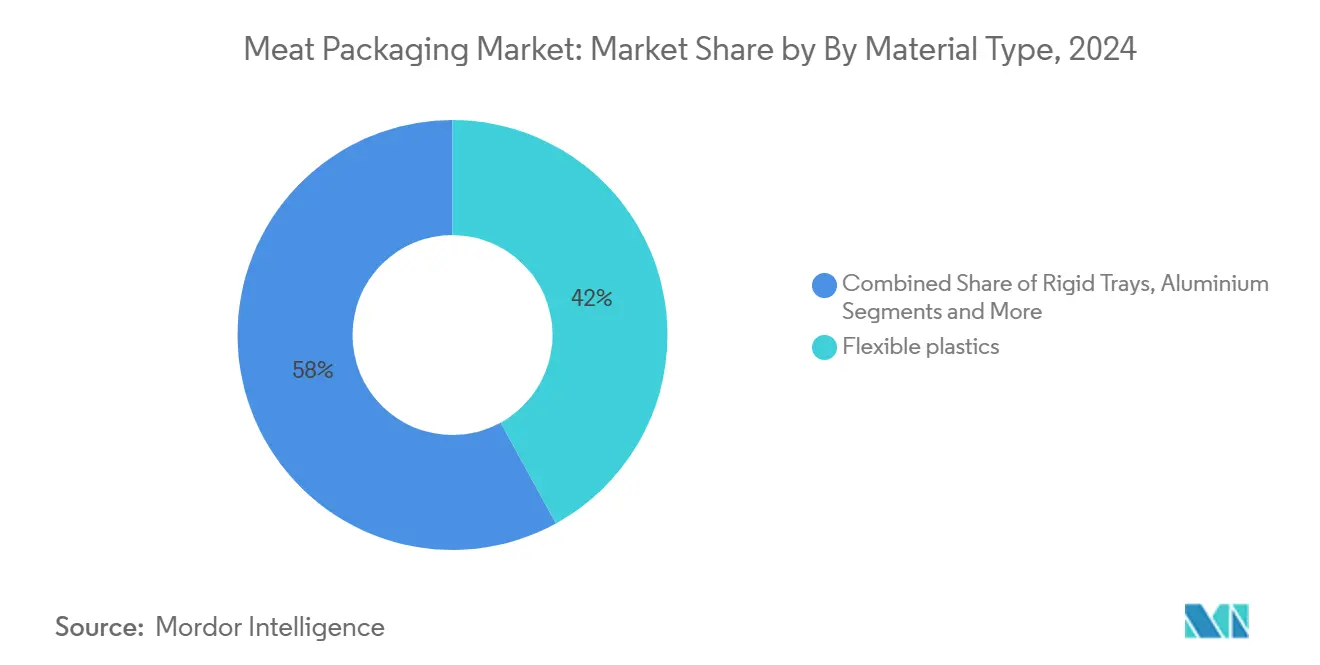
Note: Segment shares of all individual segments available upon report purchase
By Meat Type: Fresh Segment Leadership with RTE Acceleration
Fresh and frozen products generated 54% of the meat packaging market size in 2024, backed by supermarket demand for visually appealing, leak-proof trays and overwraps that endure multi-day shelf life. Growth remains healthy as cold-chain coverage widens in emerging economies. Ready-to-eat lines, from deli slices to shelf-stable jerky, grow at 5.5% CAGR as lifestyles favour convenience. These formats need high-oxygen and moisture barriers, microwave-safe seals, and consumer-friendly openings, spurring innovation in peelable lidding and portion control.
Processed meats enjoy steady share, though health trends shift some volume toward leaner cuts and plant alternatives. Packaging upgrades focus on resealable zippers and vacuum skin formats that highlight texture while minimising air pockets. Across categories, demand converges toward smart indicators that display spoilage risk, reinforcing differentiation in crowded cases and boosting shopper confidence in the meat packaging market.
By Packaging Technology: MAP Leadership with Intelligent Systems Emerging
Modified Atmosphere Packaging retained 48% of meat packaging market share in 2024 by extending freshness through precise O₂ and CO₂ blends sealed within multilayer films. Producers fine-tune gas ratios for specific cuts, balancing colour retention with microbial suppression. Active and intelligent solutions expand at a 7.8% CAGR as pH-sensitive inks, oxygen scavengers, and RFID sensors migrate from pilot to commercial runs. These tools align with retailers’ waste-reduction pledges and regulators’ traceability mandates.
Vacuum Skin Packaging secures premium steaks and export lines where deep oxygen exclusion adds weeks of chilled life. Though costlier, the format commands higher price points and reduces drip loss. Edible coatings and biodegradable films, while small, attract sustainability-minded brands hunting plastic-free shelf appeal. Each technology tier responds to distinct value drivers, collectively widening the toolkit available in the meat packaging market.
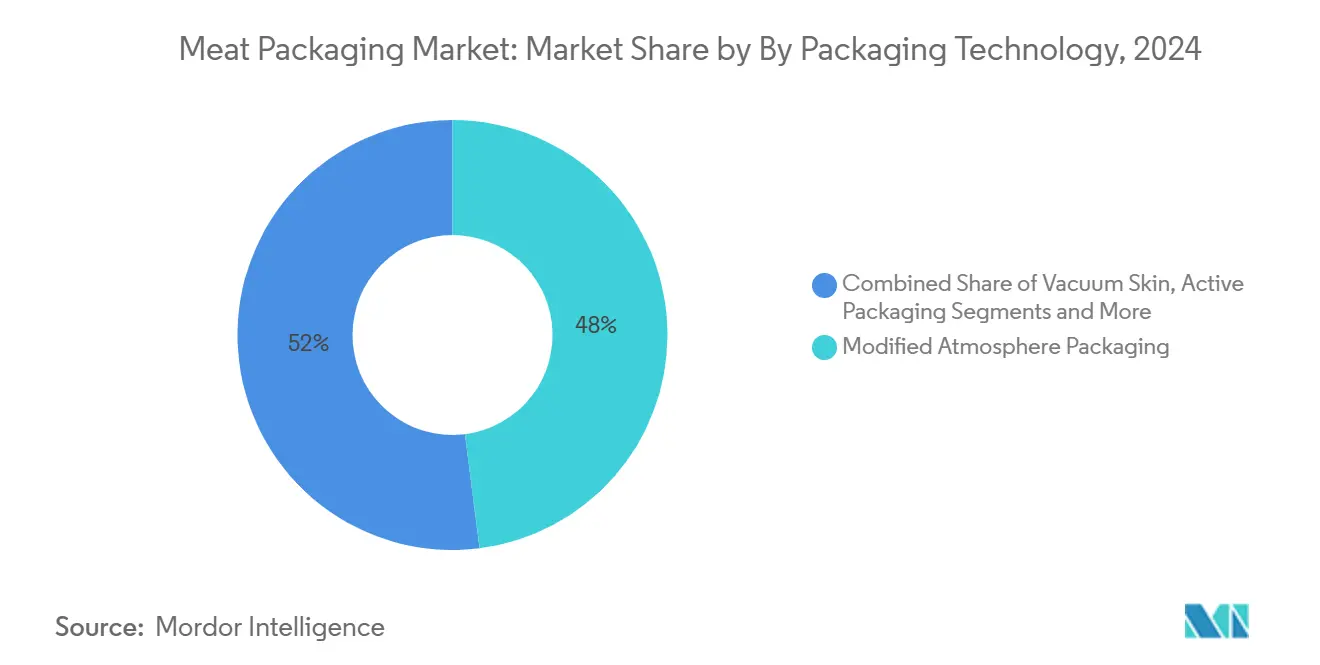
Note: Segment shares of all individual segments available upon report purchase
By End-User Channel: Retail Dominance with Digital Disruption
Supermarkets and hypermarkets contributed 51% of the meat packaging market size in 2024, leveraging visual merchandising to drive high-turnover sales. Chains standardise tray heights and film clarity specifications to streamline planograms, injecting efficiency through shared supplier scorecards. Online grocery and meal-kit services, scaling at 8.1% CAGR, set fresh demands for shock-resistant, leak-proof pouches that survive last-mile handling. Temperature-indicator labels reassure consumers about cold-chain integrity on doorstep arrival.
Foodservice and HORECA operators buy bulk packs aimed at back-of-house efficiency and waste minimisation. Vertical-form-fill-seal and large vacuum bags dominate this space for their speed and throughput in commissary kitchens. Meat processors integrate high-speed packers with robotics to match labour constraints, seeking durable films that run reliably at elevated line speeds. Channel diversification broadens specification complexity yet enlarges the addressable base for the meat packaging market.
Geography Analysis
Asia-Pacific generated 34% of the meat packaging market size in 2024, underpinned by China’s near-100 million-ton meat consumption and vigorous retail modernisation. Regional CAGR of 4.8% through 2030 reflects urbanisation and investment in cold-chain nodes from Beijing to Bangalore. China’s online beef purchases surpassed 44% share, signalling rapid uptake of e-commerce friendly packs designed for parcel networks. Indian supermarkets multiply freezer aisles, widening the addressable base for MAP and VSP solutions. Southeast Asian convenience chains follow suit, embracing standardised pouch formats that withstand humid climates.
North America combines high per-capita meat intake with mature retail infrastructure. Growth stems from technology adoption: blockchain tracing, antimicrobial films, and automation-ready baggers. Regulatory reviews spur trials of monomaterial barrier films, especially in Canada’s major chains. Europe leads in circular-economy compliance, pushing converters toward recyclable PE/PP structures and paper-fibre hybrids. Packaging firms that meet both oxygen-barrier and recyclability targets unlock preferred supplier status with EU grocers.
South America sees steady demand from Brazil’s export-oriented processors that need robust packs for transoceanic shipping. High-barrier pouches, embossed vacuum bags, and strong corrugated outers are standard. Middle East & Africa exhibit uneven penetration; Gulf retailers specify premium MAP steaks, while many African markets still rely on butcher paper. Cold-chain gaps limit adoption but infrastructure investments and quick-commerce pilots point to gradual uptake. Together, these geographic dynamics foster multi-speed growth paths that expand the global meat packaging market.
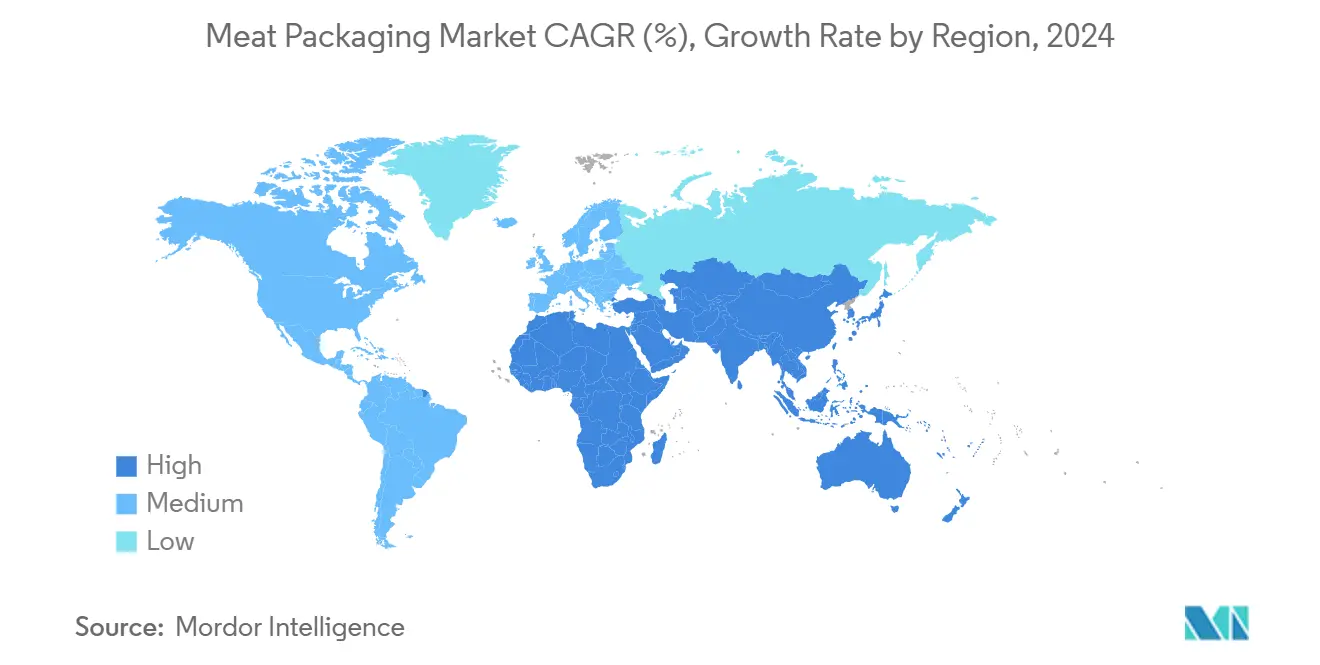
Competitive Landscape
The sector shows moderate concentration. Amcor, Sealed Air, and Berry Global channel R&D budgets into barrier innovations, automation-ready equipment, and recyclability upgrades to defend share. The proposed USD 8.4 billion merger between Amcor and Berry Global would create a powerhouse able to harmonise resin procurement, film extrusion, and converting across continents, amplifying bargaining power with retailers. Mid-tier firms pursue niches such as compostable thermoforms or antimicrobial coatings, differentiating through agility rather than sheer scale.
Strategic partnerships rise as converters team with sensor firms to roll out intelligent packs. Early projects bundle blockchain ledgers with NFC freshness tags, capturing premium positioning at gourmet grocery chains. Automation is another battleground: lines featuring AI vision inspection and robotic loaders cut labour costs and reduce contamination risk, appealing to processors squeezed by workforce shortages. Sustainability credentials remain a baseline expectation; companies unable to document recyclability, low-carbon operations, or EPR readiness risk delisting from retailer sourcing lists. Competitive dynamics therefore hinge on technology integration, regulatory foresight, and supply-chain resilience across the meat packaging market.
Meat Packaging Industry Leaders
-
Amcor plc
-
Sealed Air Corporation
-
Berry Global Group Inc.
-
Mondi plc
-
Crown Holdings Inc.
- *Disclaimer: Major Players sorted in no particular order
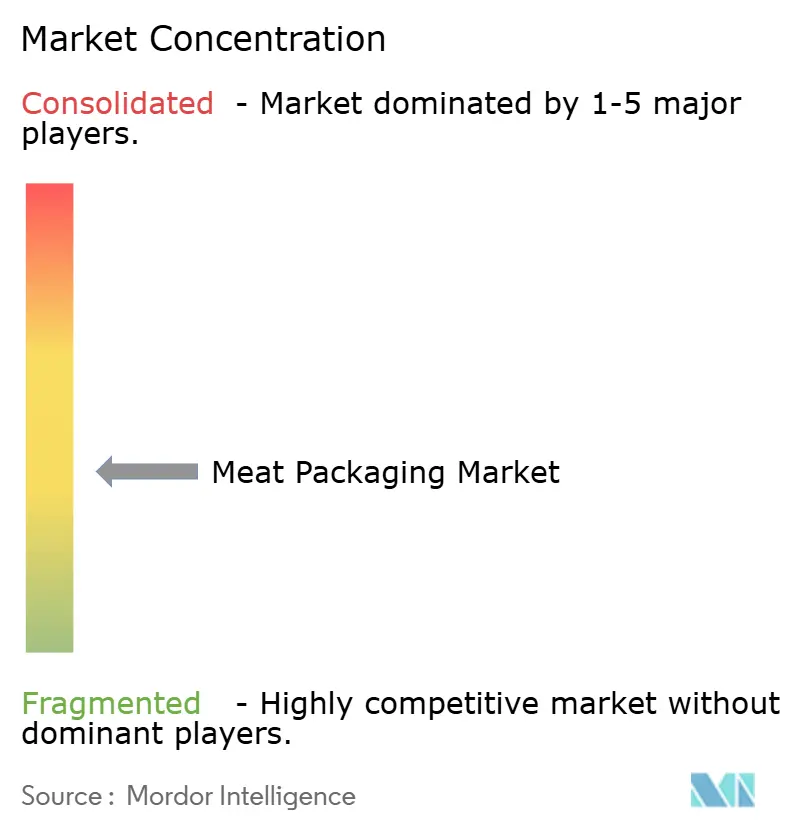
Recent Industry Developments
- June 2025: Cargill announced a USD 90 million investment in automation for its Colorado beef processing plant, focusing on yield enhancement and waste reduction technologies that will require compatible packaging systems capable of integrating with robotic handling equipment.
- May 2025: Multivac showcased advanced meat slicing automation at IFFA 2025, signing a cooperation agreement with Provisur Technologies to enhance high-output slicing solutions for bacon and raw ham applications, emphasizing sustainability through reduced plastic use and improved operational efficiency.
- February 2025: Smurfit Westrock reported strong Q4 2024 results with net sales of approximately USD 7.5 billion, highlighting operational expertise in sustainable packaging solutions crucial for meat packaging applications while achieving USD 400 million in synergy savings.
- January 2025: Amcor unveiled its IPPE 2025 showcase featuring the Moda Loader, Moda Bag with AI vision technology, and Moda Vac 20 rotary vacuum packaging systems designed to enhance operational efficiency and safety in protein processing sectors.
Global Meat Packaging Market Report Scope
Packaging plays a vital role in preserving the term and extent of the shelf life of meat. The meat can be compromised without packaging as it is contaminated by direct contact with chemical, physical, and biological contaminants. The study tracks the demand for the market through the revenue accrued by the value of the consumption of different types of packaging solutions used for meat packaging.
The market is segmented by material type (plastic and metal), type of meat (fresh and frozen, processed, and ready-to-eat), and geography. The scope of this study is currently focused on the key regions, such as North America, Europe, Asia-Pacific, Latin America, and the Middle East & Africa. The market sizes and forecasts are provided in terms of value (USD) for all the above segments.
| Plastic | Flexible Pouches | Bags |
| Films and Wraps | ||
| Other Flexible | ||
| Rigid Trays and Containers | Other Rigid | |
| Metal | Aluminium | |
| Steel | ||
| Other Metals | ||
| Fresh and Frozen |
| Processed |
| Ready-to-Eat |
| Modified Atmosphere Packaging (MAP) |
| Vacuum Skin Packaging (VSP) |
| Active and Intelligent Packaging |
| Edible and Biodegradable Films |
| Retail (Supermarkets / Hypermarkets) |
| Food-service / HORECA |
| Online Grocery and Meal-kit |
| Meat Processors / Packers |
| North America | United States |
| Canada | |
| Mexico | |
| Europe | United Kingdom |
| Germany | |
| France | |
| Italy | |
| Rest of Europe | |
| Asia-Pacific | China |
| Japan | |
| India | |
| South Korea | |
| Rest of Asia-Pacific | |
| Middle East | Israel |
| Saudi Arabia | |
| United Arab Emirates | |
| Turkey | |
| Rest of Middle East | |
| Africa | South Africa |
| Egypt | |
| Rest of Africa | |
| South America | Brazil |
| Argentina | |
| Rest of South America |
| By Material Type | Plastic | Flexible Pouches | Bags |
| Films and Wraps | |||
| Other Flexible | |||
| Rigid Trays and Containers | Other Rigid | ||
| Metal | Aluminium | ||
| Steel | |||
| Other Metals | |||
| By Meat Type | Fresh and Frozen | ||
| Processed | |||
| Ready-to-Eat | |||
| By Packaging Technology | Modified Atmosphere Packaging (MAP) | ||
| Vacuum Skin Packaging (VSP) | |||
| Active and Intelligent Packaging | |||
| Edible and Biodegradable Films | |||
| By End-user Channel | Retail (Supermarkets / Hypermarkets) | ||
| Food-service / HORECA | |||
| Online Grocery and Meal-kit | |||
| Meat Processors / Packers | |||
| By Geography | North America | United States | |
| Canada | |||
| Mexico | |||
| Europe | United Kingdom | ||
| Germany | |||
| France | |||
| Italy | |||
| Rest of Europe | |||
| Asia-Pacific | China | ||
| Japan | |||
| India | |||
| South Korea | |||
| Rest of Asia-Pacific | |||
| Middle East | Israel | ||
| Saudi Arabia | |||
| United Arab Emirates | |||
| Turkey | |||
| Rest of Middle East | |||
| Africa | South Africa | ||
| Egypt | |||
| Rest of Africa | |||
| South America | Brazil | ||
| Argentina | |||
| Rest of South America | |||
Key Questions Answered in the Report
What is the current value of the meat packaging market?
The meat packaging market is valued at USD 12.17 billion in 2025 and is projected to reach USD 14.33 billion by 2030.
Which region holds the largest share in the meat packaging market?
Asia-Pacific leads with 34% share in 2024, driven by China’s large consumption base and expanding retail infrastructure.
Which packaging technology is most widely used for meat products?
Modified Atmosphere Packaging commands 48% share, reflecting its effectiveness in extending shelf life and preserving colour.
How fast is online grocery influencing meat packaging demand?
Online grocery and meal-kit channels are expanding at an 8.1% CAGR to 2030, spurring demand for durable, leak-proof packs.
What sustainability trends are shaping the meat packaging market?
High-barrier mono-material films, recyclable structures, and intelligent freshness sensors are gaining traction under stricter regulations.
Who are the key players in the meat packaging market?
Amcor, Sealed Air, and Berry Global dominate, with competitors focusing on eco-friendly innovations and sensor-enabled smart packs.
Page last updated on:



